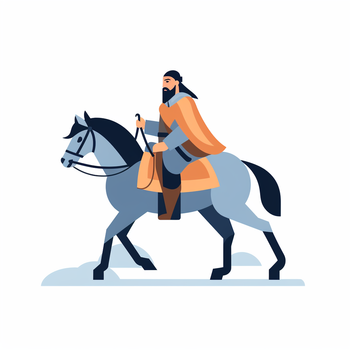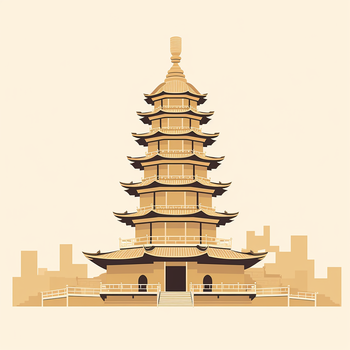Song Dynasty
|
|
- Alternative meaning: Song Dynasty (420-479)
The Song Dynasty (Chinese: 宋朝) was a ruling dynasty in China from 960-1279. Its founding marked the reunification of China for the first time since the fall of the Tang dynasty in 907. The intervening years, known as the Period of Five Dynasties and Ten Kingdoms, were a time of division between north and south and of rapidly changing administrations.
The Song dynasty itself can be divided into two distinct periods: the Northern Song and Southern Song. The Northern Song (960-1127) signifies the time when the Song capital was in the northern city of Kaifeng and the dynasty controlled all China. The Southern Song (1127-1279) refers to the time after the Song lost control of northern China to the Jurchen Jin dynasty. The Song court retreated south of the Yangtze River and made their capital at Hangzhou.
The northern Jin dynasty was overrun by the Mongols in 1234, who subsequently took control of northern China and maintained uneasy relations with the Southern Song court. The Mongol Yuan dynasty, proclaimed in 1271, finally destroyed the Song dynasty in 1279 and once more unified China, this time as part of a vast Mongol empire.
| Contents |
Arts, culture and economy
The founders of the Song dynasty built an effective centralized bureaucracy staffed with civilian scholar-officials. Regional military governors and their supporters were replaced by centrally appointed officials. This system of civilian rule led to a greater concentration of power in the emperor and his palace bureaucracy than had been achieved in the previous dynasties.
The Song dynasty is notable for the development of cities not only for administrative purposes but also as centers of trade, industry, and maritime commerce. The landed scholar-officials, sometimes collectively referred to as the gentry, lived in the provincial centers alongside the shopkeepers, artisans, and merchants. A new group of wealthy commoners - the mercantile class - arose as printing and education spread, private trade grew, and a market economy began to link the coastal provinces and the interior. Landholding and government employment were no longer the only means of gaining wealth and prestige. The development of paper money and a unified tax system meant the development of a true nationwide market system.
Accompanying this was the beginnings of what one might term the Chinese industrial revolution. For example the historian Robert Hartwell has estimated that per capita iron output rose sixfold between 806 and 1078 (AD), such that, by 1078 China was producing 125,000 tons of iron per year. This iron was used to mass produce ploughs, hammers, needles, pins, cymbals (etc. etc.) for an indigenous mass market and for trade with the outside world, which also expanded greatly at this point. Concurrently the Chinese invented or developed gunpowder, the cannon, the flamethrower, printing technology, amongst many other things. As a result of these innovations (and the concurrent agricultural revolution) China boasted some of the largest cities of the world at this time. For example it has been estimated that Hangzhou had 500,000 inhabitants at this point: far larger than any European city.
Culturally, the Song refined many of the developments of the previous centuries. Included in these refinements were not only the Tang ideal of the universal man, who combined the qualities of scholar, poet, painter, and statesman, but also historical writings, painting, calligraphy, and hard-glazed porcelain. Song intellectuals sought answers to all philosophical and political questions in the Confucian Classics. This renewed interest in the Confucian ideals and society of ancient times coincided with the decline of Buddhism, which the Chinese regarded as foreign and offering few practical guidelines for the solution of political and other mundane problems.
The Song Neo-Confucian philosophers, finding a certain purity in the originality of the ancient classical texts, wrote commentaries on them. The most influential of these philosophers was Zhu Xi (1130-1200), whose synthesis of Confucian thought and Buddhist, Taoist, and other ideas became the official imperial ideology from late Song times to the late 19th century. As incorporated into the examination system, Zhu Xi's philosophy evolved into a rigid official creed, which stressed the one-sided obligations of obedience and compliance of subject to ruler, child to father, wife to husband, and younger brother to elder brother. The effect was to inhibit the societal development of premodern China, resulting both in many generations of political, social, and spiritual stability and in a slowness of cultural and institutional change up to the 19th century. Neo-Confucian doctrines also came to play the dominant role in the intellectual life of Korea, Vietnam, and Japan.
Fall of the Southern Song
In 1276 the Southern Song court fled to Guangdong by boat, fleeing Mongol invaders, leaving Emperor Gong of Song China behind. Any hope of resistance was centred on two young princes, Emperor Gong's brothers. The older boy, Zhao Shi, who was nine years old, was declared emperor; and in 1277, the imperial court sought refuge in Silvermine Bay (Mui Wo) on Lantau Island and later in what is today Kowloon City, Hong Kong (see also Sung Wong Toi). The older brother became ill and died, and was succeeded by the younger, Zhao Bing, aged seven. On March 19, 1279 the Song army was defeated in its last battle, the Battle of Yamen, fought against the Mongols in the Pearl River Delta; subsequently a high official is said to have taken the boy emperor in his arms and jumped from a clifftop into the sea, drowning both of them. (See: Sung Wong Toi.) These emperors are also believed to have held court in the Tung Chung valley, which takes its name from a local hero who gave up his life for the emperor. Hau Wong, an official from this court, is still revered as a god in Hong Kong.
Song dynasty emperors
| Temple Names ( Miao Hao 廟號 Miào Hào) | Posthumous Names ( Shi Hao 諡號 ) | Born Names | Period of Reigns | Era Names (Nian Hao 年號) and their according range of years |
|---|---|---|---|---|
| Convention: "Song" + temple name or posthumous name except last emperor who was revered as Song Di Bing (宋帝昺 Sòng Dì Bǐng) | ||||
| Bei (Northern) Song dynasty, 960- 1127 | ||||
| Taizu (太祖 Tàizǔ) | too tedious; thus, not used when referring to this sovereign | Zhao Kuangyin (趙匡胤 Zhào Kuāngyìn) | 960-976 | Jianlong (建隆 Jiànlóng) 960-963Qiande (乾德 Qiándé) 963-968 |
| Taizong (太宗 Tàizōng) | too tedious; thus, not used when referring to this sovereign | Zhao Kuangyi (趙匡義 Zhào Kuāngyì) or Zhao Guangyi (趙光義 Zhào Guāngyì) | 976-997 | Taipingxingguo (太平興國 Tàipíngxīngguó) 976-984Yongxi (雍熙 Yōngxī) 984-987 |
| Zhenzong (真宗 Zhēnzōng) | too tedious; thus, not used when referring to this sovereign | Zhao Heng (趙恆 Zhào Héng) | 997-1022 | Xianping (咸平 Xiánpíng) 998-1003Jingde (景德 Jǐngdé) 1004-1007 |
| Renzong (仁宗 Rénzōng) | too tedious; thus, not used when referring to this sovereign | Zhao Zhen (趙禎 Zhào Zhēn) | 1022-1063 | Tiansheng (天聖 Tiānshèng) 1023-1032Mingdao (明道 Míngdào) 1032-1033 |
| Yingzong (英宗 Yīngzōng) | too tedious; thus, not used when referring to this sovereign | Zhao Shu (趙曙 Zhào Shù) | 1063-1067 | Zhiping (治平 Zhìpíng) 1064-1067 |
| Shenzong (神宗 Shénzōng) | too tedious; thus, not used when referring to this sovereign | Zhao Xu (趙頊 Zhào Xū) | 1067-1085 | Xining (熙寧 Xīníng) 1068-1077Yuanfeng (元豐 Yuánfēng) 1078-1085 |
| Zhezong (哲宗 Zhézōng) | too tedious; thus, not used when referring to this sovereign | Zhao Xu (趙煦 Zhào Xǔ) | 1085-1100 | Yuanyou (元祐 Yuányòu) 1086-1094Shaosheng (紹聖 Shàoshèng) 1094-1098 |
| Huizong (徽宗 Huīzōng) | too tedious; thus, not used when referring to this sovereign | Zhao Ji (趙佶 Zhào Jí) | 1100-1125 | Jianzhongjingguo (建中靖國 Jiànzhōngjìngguó) 1101Chongning (崇寧 Chóngníng) 1102-1106 |
| Qinzong (欽宗 Qīnzōng) | too tedious; thus, not used when referring to this sovereign | Zhao Huan (趙桓 Zhào Huán) | 1126-1127 | Jingkang (靖康 Jìngkāng) 1125-1127 |
| Nan (Southern) Song dynasty, 1127- 1279 | ||||
| Gaozong (高宗 Gāozōng) | too tedious; thus, not used when referring to this sovereign | Zhao Gou (趙構 Zhào Gòu) | 1127-1162 | Jingyan (靖炎 Jìngyán) 1127-1130Shaoxing (紹興 Shàoxīng) 1131-1162 |
| Xiaozong (孝宗 Xiàozōng) | too tedious; thus, not used when referring to this sovereign | Zhao Shen (趙昚 Zhào Shèn) | 1162-1189 | Longxing (隆興 Lóngxīng) 1163-1164Qiandao (乾道 Qiándào) 1165-1173 |
| Guangzong (光宗 Guāngzōng) | too tedious; thus, not used when referring to this sovereign | Zhao Dun (趙惇 Zhào Dūn) | 1189-1194 | Shaoxi (紹熙 Shàoxī) 1190-1194 |
| Ningzong (寧宗 Níngzōng) | too tedious; thus, not used when referring to this sovereign | Zhao Kuo (趙擴 Zháo Kuó) | 1194-1224 | Qingyuan (慶元 Qìngyuán) 1195-1200Jiatai (嘉泰 Jiātài) 1201-1204 |
| Lizong (理宗 Lǐzōng) | too tedious; thus, not used when referring to this sovereign | Zhao Yun (趙昀 Zhào Yún) | 1224-1264 | Baoqing (寶慶 Bǎoqìng) 1225-1227Shaoding (紹定 Shàodìng) 1228-1233 |
| Duzong (度宗 Dùzōng) | too tedious; thus, not used when referring to this sovereign | Zhao Qi (趙祺 Zhào Qí) | 1264-1274 | Xianchun (咸淳 Xiánchún) 1265-1274 |
| did not exist | Gong Di (恭帝 Gōngdì) | Zhao Xian (趙顯 Zhào Xiǎn) | 1274-1276 | Deyou (德祐 Déyòu) 1275-1276 |
| Duan Zong (端宗 Duān Zōng) | too tedious; thus, not used when referring to this sovereign | Zhao Shi (趙是 Zhào Shì) | 1276-1278 | Jingyan (景炎 Jǐngyán) 1276-1278 |
| did not exist | Di (帝 Dì) or Wei Wang (衛王 Wèiwáng) | Zhao Bing (趙昺 Zhào Bǐng) | 1278-1279 | Xiangxing (祥興 Xiángxīng) 1278-1279 |
Related topics
es:Dinastía Song fr:dynastie Song it:Dinastia Song ja:北宋 nl:Song-dynastie pt:Dinastia Sung fi:Song-dynastia zh:宋朝



